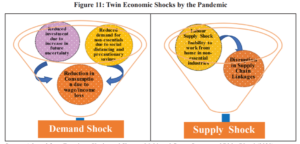The Survey says, India’s mature policy response to this “once-in-a-century” crisis provides important lessons for democracies to avoid myopic policy making and demonstrates the significant benefits of focusing on long-term gains

India adopted a unique four-pillar strategy of:
- Containment
- Fiscal Reforms
- Financial Reforms
- Long-term structural reforms.
Calibrated fiscal and monetary support was provided given the evolving economic situation, cushioning the vulnerable in the lockdown and boosting consumption and investment while unlocking, mindful of fiscal repercussions and entailing debt sustainability.
A favorable monetary policy ensured abundant liquidity and immediate relief to debtors via temporary moratoria, while unclogging monetary policy transmission.
The Survey underlines that the year 2020 was dominated by the COVID-19 pandemic and the ensuing global economic downturn, the most severe one since the Global Financial Crisis.
Global economic output is estimated to fall by 3.5 percent in 2020 (IMF January 2021 estimates).
In view of this, Governments and central banks across the world deployed a range of policy tools to support their economies such as lowering key policy rates, quantitative easing measures, loan guarantees, cash transfers and fiscal stimulus measures.
India recognized the disruptive impact of the pandemic and charted its own unique path amidst dismal projections by several international institutions of the spread in the country given its huge population, high population density and an overburdened health infrastructure.
The Survey observes that the intense lockdown implemented at the start of the pandemic – when India had only a 100 confirmed cases – characterized India’s unique response in several ways:
First, the policy response was driven by the findings from both epidemiological and economic research.
Specifically, faced with enormous uncertainty about the potential spread of the pandemic, the policy implemented the Nobel-prize winning research in Hansen and Sargent (2001) that recommends a policy focussed on minimising losses in a worst case scenario.
The scores of lives that have been saved and the V-shaped economic recovery that is being witnessed bear testimony to India’s boldness in taking short-term pain for long-term gain.
Therefore, India’s policy humane response that focused on saving human lives, recognised that the short-term pain of an initial, stringent lockdown would lead to long-term gains both in the lives saved and in the pace of the economic recovery.
Second, India recognised that the pandemic impacts both supply and demand in the economy.

- The Government of India also launched the Emergency Credit Line Guarantee Scheme to provide much needed relief to stressed sectors by helping entities sustain employment and meet liabilities.
- During the unlock phase, when uncertainty declined and the precautionary motive to save subsided, on the one hand, and economic mobility increased, on the other hand, India has ramped up its fiscal spending.
- A favorable monetary policy ensured abundant liquidity and immediate relief to debtors via temporary moratoria, while unclogging monetary policy transmission.
- India’s demand-side policy, thus, underscores the idea that pressing on the accelerator while the brakes are clamped only wastes scarce fuel.
The year 2020 threw at the world a bedlam of the novel COVID-19 virus, threatening all that was taken for granted –mobility, safety, and a normal life itself. This inherent trade-off led to the policy dilemma of “lives versus livelihoods”.
















